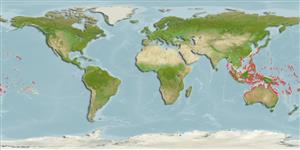Common names from other countries
>
Eupercaria/misc (Various families in series Eupercaria) >
Labridae (Wrasses) > Corinae
Etymology: Halichoeres: Greek, als, alis = salt + Greek, choiros = pig (Ref. 45335).
More on author: Valenciennes.
Environment: milieu / climate zone / depth range / distribution range
Ekologi
marina revassocierade; djupintervall 0 - 5 m (Ref. 30874). Tropical; 32°N - 32°S, 91°E - 133°W
Indo-Pacific: Cocos Island in the eastern Indian Ocean to the Line and Tuamoto islands, north to southern Japan, south to New South Wales and Lord Howe Island. Replaced by Halichoeres nebulosus in the western Indian Ocean.
Size / Vikt / Age
Maturity: Lm ? range ? - ? cm
Max length : 12.5 cm SL hane/ej könsbestämd; (Ref. 9823)
Short description
Bestämningsnycklar | Morfologi | Morfometri
Taggstrålar i ryggfenan (totalt) : 9; Mjukstrålar i ryggfenan (totalt) : 11; Taggstrålar i analfenan: 3; Mjukstrålar i analfenan: 11. Females olivaceous on back, the scale edges dark brown, pale ventrally, with whitish blotches of unequal size and a large pink area posteriorly on the abdomen; a black spot on opercular flap, small one behind eye, one at front of dorsal fin and a large one rimmed in yellow or blue in middle of fin; no black spot at upper base of pectoral fins; males green with orange-red spots, some linked to form irregular markings, the white blotches and large pink area on abdomen lost, and the black spots lost or reduced. Males are distinguished by different cheek patterns. In this species, it has a near horizontal pink band below the eye (Ref. 48636).
Inhabits shallow reefs and rocky shores, usually in weedy areas exposed to surge (Ref. 9710, 48636). Feeds on benthic crustaceans, mollusks, polychaetes, forams, fishes, and fish eggs (Ref. 1602). One of several similar species that have near identical juvenile and female stages (Ref. 48636).
Life cycle and mating behavior
Maturities | Reproduktion | Spawnings | Egg(s) | Fecundities | Larver
Distinct pairing during breeding (Ref. 205).
Randall, J.E., G.R. Allen and R.C. Steene, 1990. Fishes of the Great Barrier Reef and Coral Sea. University of Hawaii Press, Honolulu, Hawaii. 506 p. (Ref. 2334)
IUCN Red List Status (Ref. 130435)
CITES (Ref. 128078)
Not Evaluated
Threat to humans
Harmless
Human uses
Fiskeri: kommersiell; Akvarium: Kommersiell
Verktyg
Special reports
Download XML
Internet-källor
Estimates based on models
Preferred temperature (Ref.
115969): 24.7 - 29.1, mean 28.4 (based on 1912 cells).
Phylogenetic diversity index (Ref.
82804): PD
50 = 0.5000 [Uniqueness, from 0.5 = low to 2.0 = high].
Bayesian length-weight: a=0.00955 (0.00451 - 0.02020), b=3.09 (2.92 - 3.26), in cm Total Length, based on LWR estimates for this Genus-body shape (Ref.
93245).
Trofisk nivå (Ref.
69278): 3.7 ±0.50 se; based on food items.
Resiliens (Ref.
120179): Hög, lägsta populationsfördubblingstid mindre än 15 månader (Preliminary K or Fecundity.).
Fishing Vulnerability (Ref.
59153): Low vulnerability (10 of 100).
